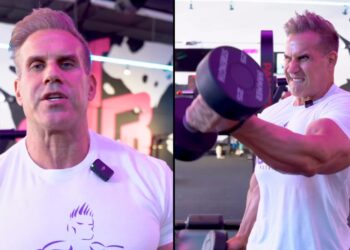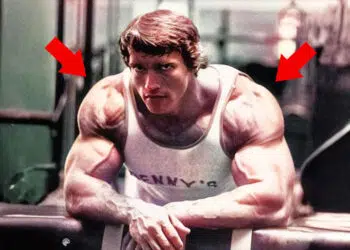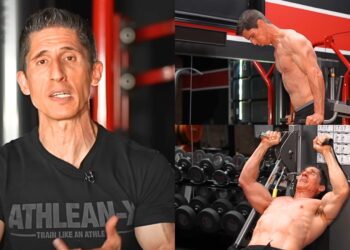Most strength training exercises are done using a slow, controlled tempo. This keeps your muscles under near-constant tension which, research suggests, may help increase muscle growth (1).
Slow-tempo exercises also eliminate momentum which means they’re often more challenging and easier on your joints than the same exercise done quickly.
However, there are times when lifting faster will produce better results, and there are several exercises that only work when you do them explosively. Examples include power cleans, squat jumps, kettlebell swings, and plyo push-ups.
These types of exercise improve explosive strength, also known as muscle power, which is the ability to generate force quickly. Power is an integral part of most sports and plays a critical part in many strenuous everyday activities, such as bounding up stairs, quickly changing direction while walking or running, and lifting heavy objects off the ground.
I’m a veteran personal trainer and my job involves creating programs that meet my client’s needs. As many of them are athletes or simply want fitness they can use out in the real world, this means I often have to prescribe both slow and fast exercises.
In this article, I explain how to do the Neider press. This old-school exercise is named after Olympic shot-putter Bill Neider (August 10, 1933 – October 7, 2022) who used it to build a muscular upper body and incredible pushing power.
Level Up Your Fitness: Join our 💪 strong community in Fitness Volt Newsletter. Get daily inspiration, expert-backed workouts, nutrition tips, the latest in strength sports, and the support you need to reach your goals. Subscribe for free!
Neider Press Correct Form
Neider presses are a challenging, tricky exercise that, if done incorrectly, will be less effective and could even cause injury. So, make sure you start light and learn to do them correctly. That way, you’ll enjoy all the benefits this exercise has to offer without suffering unnecessary pain.
- Hold a barbell with a shoulder-width overhand grip. Wrap your thumbs around the bar for security – do not use a thumbless/false grip.
- Stand with your feet shoulder-width apart, knees slightly bent, core braced, and shoulders down and back.
- Raise the weight to your chest so your arms are parallel to the floor.
- Explosively extend your arms and “throw” weight out to arm’s length. However, do NOT let go!
- You can keep your arms horizontal or, alternatively, drive the bar out and up to around head height, i.e., an inclined movement.
- Pull the bar back into your chest and repeat for the desired number of reps.
Neider Press: Muscles Worked
The Neider press is a compound exercise meaning it involves two or more joints and several muscles working together. While your pushing muscles are responsible for driving the bar away from your chest, you’ll need to use your back and biceps to pull the bar back in. As such, this exercise engages virtually all your upper body muscles.
The main muscles developed by this exercise are:
- Pectoralis major
- Deltoids (anterior, medial, posterior)
- Triceps
- Trapezius
- Rhomboids
- Biceps
- Core (rectus abdominis, obliques, transverse abdominis, erector spinae)
Pro-Trainer Tips
Get more from the Neider press with these tried-and-tested pro-trainer tips:
Start Light
Using too much weight will make Neider presses ineffective and even dangerous. You must be able to keep the weight level with your chest and drive it out explosively. If the weight drops or your movements are slow, you are not doing the exercise correctly and it won’t be as effective. Check your ego, go light, and you’ll get better results from your training.
Push and Pull Explosively
The Neider press should be called the Neider press AND pull, as you must row the bar back in as powerfully as you push it away. This sets up the stretch reflex, which plays a critical part in every explosive exercise. The more rapidly you pull the bar back toward you, the more rapidly you’ll stretch your muscles, and the more strongly they will contract.
Experiment with a Staggered Stance
While it’s common to do the Neider press in a conventional shoulder-width stance, in my experience, standing with one foot in front of the other, i.e., a staggered stance, provides more stability and makes it easier to push and pull the weight faster. Try both stances to see which you prefer.
Some people also add a coordinated split jump during the Neider press, switching their lead leg rep by rep. This can be tricky to master but may help you keep your balance as you rapidly push and pull the bar.
Chalk Your Hands
The last thing you want is for the barbell to slip out of your hands as you drive it away from your chest. At best that would disrupt your set, and at worst it could cause property damage or injury. Apply gym chalkto your hands before every set to stop your palms from slipping.
End your Set When Your Speed/Power Noticeably Decrease
Your body adapts to the type of training you do. This is the law of fitness specificity. Consequently, you should stop doing Neider presses if you notice your speed/power is starting to decrease. Slow-speed reps train you to become slower, which is the exact opposite of what the Neider press is supposed to achieve.
Neider Press Mistakes to Avoid
Make Neider pressesas safe as possible by avoiding these common mistakes:
Not Bracing Your Core
Personal trainers often say that you can’t fire a cannon out of a canoe. What they really mean is that your muscles need a solid foundation from which to work. In the Neider press, this means you MUST brace your core from the start of your set to the end.
Failure to do so could mean you end up going backward when the bar should be going forward. Not keeping your core engaged could also lead to injury.
Brace your core by tensing your abs like you were expecting a gut punch, pulling up your pelvic floor, and inhaling into your abdomen. This should make your midsection feel solid and strong. Maintain this sensation throughout your set, and do not allow your core to relax.
Level Up Your Fitness: Join our 💪 strong community in Fitness Volt Newsletter. Get daily inspiration, expert-backed workouts, nutrition tips, the latest in strength sports, and the support you need to reach your goals. Subscribe for free!
Not Being Explosive
Calling this exercise a press is a little misleading. In reality, it’s a throw, catch, and pull. In other words, the Neider press should be done explosively, like you are trying to throw the barbell out in front of you. This is one of the few exercises where momentum is not just acceptable, but it’s actively encouraged.
Doing Neider Presses Without a Strength and Fitness Foundation
There is a reason you won’t see many people doing Neider presses – this is an advanced, specialized exercise. As such, you should not attempt it if you are a beginner and have yet to master conventional bench and shoulder presses.
Doing this exercise too soon on your lifting journey could lead to serious shoulder injuries. Develop a broad foundation of strength and fitness before attempting the Neider press. Even then, it may not be appropriate for your current training needs and goals, and the risks may outweigh any potential benefits.
Neider Press Benefits
Not sure if Neider presses deserve a place in your workouts? Consider these benefits and then decide.
Develop a More Powerful Upper Body
While being strong is a valuable fitness component, it doesn’t mean you’ll be able to generate force quickly, e.g., when throwing a baseball or a punch. The Neider press is a bonafide power exercise that trains your muscles to produce lots of force very rapidly. It’s for this reason that athletes perform Neider presses.
More Muscle Mass
Your muscles comprise three main types of fibers – type 1, type 2a, and type 2b. Of the three, type 2b is mostly responsible for the size and strength of your muscles. Research suggests that rapid movements are best for recruiting type 2b fibers (2). As such, the Neider press has the potential to increase upper-body muscle mass more than some slower-speed exercises.
Great for Circuit Training
Circuit training is one of the most versatile workout methods. It can be adapted to build strength, mass, power, fitness, or for fat burning. The fast-paced Neider press is a great circuit training exercise, which is one of my favorite ways to prescribe and program this unique movement.
Variety and Fun
Are you bored of doing the same old chest and shoulder presses? I hear you! While such exercises are undeniably effective, doing them over and over again can be tedious. The Neider press is a reliable way to make your workouts more varied and fun.
Neider Press Variations and Alternatives
While the classic Neider press is a great exercise, I recognize that it might not be suitable for everyone and that doing it too frequently could make it boring or less effective. So, to that end, here are five equally effective exercises for improving upper body pushing power.
Dumbbell Neider Press
No barbell? No problem! A lot of home exercises have neither the space nor the funds for full-sized barbells, but that’s okay because you can do Neider presses with dumbbells instead. You can even do this exercise using one arm at a time, which is a great variation for fighters and throwers.
Plyometric Push-Ups
Some of the best power exercises require no equipment and use your body weight for resistance. Plyometric (plyo) push-ups are every bit as effective as Neider presses, but arguably more accessible as you can do them anywhere and anytime. You can do plyo push-ups with or without a mid-air clap.
Smith Machine Bench Press Throw
A lot of trainers don’t like the Smith machine, but most of this hate is unfounded because it can be a useful training tool. The Smith machine bench press throw is an excellent upper body power exercise that, because of the weight guide rods and catchers, is much safer than doing this exercise with freeweights.
Supine Medicine Ball Chest Pass Throw
Partner medicine ball exercises were a big part of my training as an up-and-coming athlete. Working out with a partner encourages you to raise your game and put more effort into your workouts. Supine medicine ball chest pass throws are an excellent exercise for developing reactive strength and power, not to mention timing and hand-eye coordination.
Kneeling Medicine Ball Chest Throw
While I have nothing but love for partner medicine ball exercises, I realize that not everyone can or wants to train with another person. That’s not a problem because this is a solo exercise that even the most solitary lifter can do provided they have access to a smooth, strong wall and a suitable medicine ball.
Closing Thoughts
The Neider press is a unique exercise that builds upper body power and speed for athletic performance and everyday strength. While it may take some time to learn and master, the payoff will be worth the effort.
Combined with other power and speed exercises, this movement will help you reach new heights in your fitness journey.
However, this is not an exercise for beginners, and non-athletes may find the risk of injury outweighs the benefits. The good news is that there are safer alternatives to the Neider press that offer many of the same benefits, several of which are featured in this article.
All that said, despite being something of a forgotten exercise, the Neider press remains a legitimate and effective movement. Like many old-school exercises, it provides a useful alternative to more conventional strength and conditioning techniques.
References:
- Warneke K, Lohmann LH, Lima CD, Hollander K, Konrad A, Zech A, Nakamura M, Wirth K, Keiner M, Behm DG. Physiology of Stretch-Mediated Hypertrophy and Strength Increases: A Narrative Review. Sports Med. 2023 Nov;53(11):2055-2075. doi: 10.1007/s40279-023-01898-x. Epub 2023 Aug 9. PMID: 37556026; PMCID: PMC10587333.
- Mota JA, Gerstner GR, Giuliani HK. Motor unit properties of rapid force development during explosive contractions. J Physiol. 2019 May;597(9):2335-2336. doi: 10.1113/JP277905. Epub 2019 Apr 7. PMID: 30919962; PMCID: PMC6487929.
Interested in measuring your progress? Check out our strength standards for Bench Press, Push Ups, Smith Machine Bench Press, and more.








